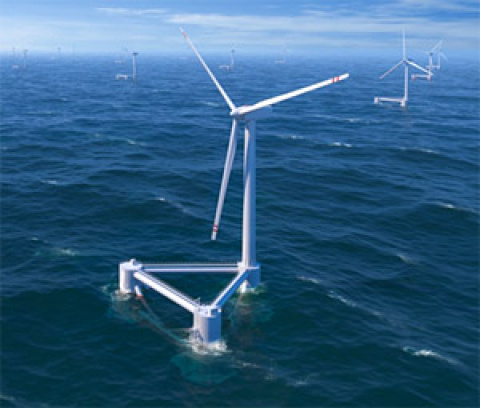PNNL Reviews Wildlife-Interaction Monitoring for Offshore Wind Farms — Technology Hybrids Show Best Potential
Wind Energy Technologies Office
February 24, 2012This is an excerpt from the First Quarter 2012 edition of the Wind Program R&D Newsletter.
Adding offshore wind to the U.S. renewable energy portfolio promises access to a large, reliable new energy source that is less subject to some of the challenges faced by land-based wind development, e.g., space limitations, conflicts with existing uses, variable wind speeds, and threats to terrestrial wildlife. However, offshore wind farms present a number of other challenges. The ocean and Great Lakes' environments are harsh; working at sea is expensive and dangerous; and construction, operation, and maintenance of the wind turbines may put animals in the water and air at risk. Regulatory agencies require developers to monitor the wildlife in an area prior to permitting to provide a baseline for the agencies and to determine the potential for harmful interactions with wind turbines.
But using human observers near wind farms can be dangerous and expensive, which makes the use of remote technologies to enumerate and track interactions of aquatic and avian wildlife with wind turbines preferable.
Pacific Northwest National Laboratory (PNNL) recently completed a study assessing technologies appropriate for monitoring birds, bats, and aquatic animals such as marine mammals, sea turtles, and fish in the offshore wind farm environment. Informed by monitoring results and research studies related to offshore wind farms in Europe, the study will help wind developers and researchers plan for development along U.S. coastlines.
Traditionally, offshore wildlife populations have been monitored by trained observers onboard ships or airplanes. Although these visual survey methods are still used, new technologies—radar, thermal and optical imaging, and acoustic detection techniques—are being deployed to address limitations of the traditional methods.
Imaging technologies used for counting and estimating the number of offshore animals include thermal infrared imaging, high-definition cameras, and satellite imagery. Although these technologies can provide extensive data, a suite of challenges associated with their use must be overcome to effectively monitor wildlife in offshore environments. Infrared (thermal) imaging provides the ability to examine interactions of birds with offshore wind turbines, including collisions with the wind farm structures. The newest and perhaps most promising imaging technology applied to offshore wind farms in Europe is high-definition aerial videography, which is used to identify and enumerate birds from airplanes flown at low altitudes. The same aerial videography shows promise for monitoring sea turtles and marine mammals near the sea surface. Tracking of tagged animals flying or swimming near wind turbines by satellite also shows considerable promise as is it a more accurate way to determine the movement of animals. However, tagging of animals is expensive and subject to extensive regulatory scrutiny, resulting in a very limited number of tagged animals in the United States.
Acoustic methods include passive acoustics to listen for bird calls in air and marine mammal calls in water, as well as active acoustics in water (also called sonar) to locate marine mammals, sea turtles, and large fish. The acoustic technologies provide additional information for identifying and tracking birds, adding to information collected using radar and aerial videography, and augment aerial video data capture for marine mammals and turtles.
Although currently no single technology provides adequate monitoring for any single group of animals, hybridized systems of several technologies look promising. The development of software tools and the validation of models that describe interactions of animals with wind farms are also expected to improve detection of avian and aquatic animals around wind farms.
DOE's Pacific Northwest National Laboratory (PNNL) is working to enable higher penetration of wind power utilizing expertise in environmental sciences, atmospheric sciences, and grid management. In addition to the environmental work to support the acceleration of the offshore wind facilities, PNNL is conducting a multi-season meteorological field study to develop data products that can evaluate the performance of atmospheric models and quantify farm and turbine inflow conditions in complex terrain. PNNL is also evaluating the effectiveness of grid integration strategies such as virtual balancing areas, sharing of regulation resources, operating reserves, area control error, and control room use of forecasting to address wind and load variability on the utility grid in the Pacific Northwest.


